100 years of transformation in the Baltics
Scientists from the Baltic states and Norway have started building a database of information on the Baltic states including gross domestic product (GDP) figures that will cover the past 100 years.
In May 2021, Vidzeme University of Applied Sciences (hereinafter – ViA) with partners from Universities of Tartu and Vilnius as well as the Norwegian School of Economics began working on an ambitious research project within the framework of the Baltic Research Program.

The project “Quantitative data about societal and economic transformations in the regions of the three Baltic States during the last hundred years for the analysis of historical transformations and the overcoming of future challenges” (BALTIC100)” will preserve quantitative data by creating a data repository reflecting social and economic transformations in the three Baltic regions over the last hundred years in order to provide a quantitative analysis of long-term development trends in the region since 1920.
The project leader is Gatis Krūmiņš, a leading researcher at ViA. His explanation concerning the topicality of the project: “We have managed to gather a strong, interdisciplinary team of scientists from the Baltics and Scandinavia that will work to increase the knowledge base concerning our countries.
And this is not just a question of economics. This knowledge will allow us to analyze historical events which are still interpreted tendentiously by various parties for various reasons. For example, events in the Baltic states during the occupation of the USSR."
The project involves experienced researchers from Estonia (Olaf Mertelsmann and Martin Klesment, University of Tartu), Lithuania (Zenon Norkus, Vilnius University) and Norway (Ola Honningdal Grytten, Norwegian School of Economics), as well as young scientists who will develop their doctoral dissertations during the project.
A statistical data repository will be created, where data series on demographic and socio-economic development indicators will be available up to the regional level. This repository will serve as an open source of reliable information for planning and forecasting different scenarios in regional policy-making as well as for media literacy and strategic communication needs. The project plans to prepare a collective monograph and eight high-quality research papers to be published in international publishing houses.
The Baltic100 project is one of the projects of the Baltic Research Program financially supported by the European Economic Area (EEA) grants. The implementation of the project started on May 1, 2021, with funding in the amount of 999092.70 euros available until 2024.
Research
Norkus, Z., Markeviciute, J., Grytten, O. H., Krūmiņš, G. (2023). Demographic Continuity as a Necessary Condition of Performable Post-communist Token Social Restorations, Filosofija. Sociologija
Norkus, Z., Jasilionis D., Grytten, O., Mežs, I., Klesment, M. (2022). Mortality Transition in the Interwar Baltic States: Findings from Cross-Country Comparison of New Life Tables, Scandinavian Economic History Review
Grytten O. H., Norkus Z., Markevičiūtė J., Šiliņš J. (2022). Can the economic growth of interwar Latvia be estimated by contemporary national accounts?, Baltic Journal of Economics
Norkus, Z., Grytten, O., Šiliņš, J., Klimantas, A. (2022). Benchmarking Latvia’s Economy: A New Estimate of Gross Domestic Product in the 1930s, Cliometrica, Springer Journal
Norkus, Z. (2022). Handbook of Economic Nationalism, Chapter 6: Varieties of currency nationalization and denationalization, pp. 81-99
Klimantas, A., Norkus, Z., Grytten O., Šiliņš, J. (2023). Reinventing Persihed "Belgium of the East": New Estimates for GDP for Inter-war Latvia (1920-1939), Cliometrica, Springer Journal
Klimantas, A. (2022). Lithuanian Economy, 1919-1940: Stagnant But Resilient. The First Interwar GDP Time-Series Estimates and their Implications, Scandinavian Economic History Review
Norkus, Z., Markevičiūtė, J., Grytten, O., Krūmiņš, G. (2023). New Gross Domestic Product (GDP) Benchmark Estimate for Latvia in 1935. November 28th-29th 2022, Rzeszów, Poland. Proceedings of the Central European Congress of Economic History: Modernization Processes in "Younger Europe". Under review.
Norkus, Z., Markevičiūtė, J., Grytten, O., Krūmiņš, G. (2023). Demographic Continuity as a Factor in the Post-Communist Restorations. Filosofija. Sociologija. Under review.
Norkus, Z., Grytten, O., Markevičiūtė, J., Šiliņš, J. (2023). A Long-Run Perspective on Latvian Regional Gross Domestic Product Inequality, 1925-2016, Baltic Journal of Economics. Under review.